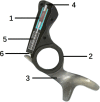Effect of a rigid ankle foot orthosis and an ankle foot orthosis with an oil damper plantar flexion resistance on pelvic and thoracic movements of patients with stroke during gait
- PMID: 36747170
- PMCID: PMC9901085
- DOI: 10.1186/s12938-023-01068-0
Effect of a rigid ankle foot orthosis and an ankle foot orthosis with an oil damper plantar flexion resistance on pelvic and thoracic movements of patients with stroke during gait
Abstract
Background: Impairments of trunk movements in gait of stroke are often reported. Ankle foot orthosis (AFO) is commonly used to improve gait of stroke; however, the effect of different types of AFOs on the pelvic and thoracic movements during gait in stroke has not been clarified.
Methods: Thirty-four patients with stroke were randomly allocated to undergo 2 weeks of gait training by physiotherapists while wearing a rigid AFO (RAFO) with a fixed ankle or an AFO with an oil damper (AFO-OD) that provides plantarflexion resistance and free dorsiflexion. A motion capture system was used for measurements of shod gait without AFO at baseline and with and without AFO after gait training. Two-way repeated ANOVA, Wilcoxon signed-rank test, and Mann-Whitney U test were performed for the data after the gait training to know the effect of different kinds of AFOs.
Results: Twenty-nine patients completed the study (AFO-OD group: 14, RAFO group: 15). Interactions were found in pelvic rotation angle, change of shank-to-vertical angle (SVA) in the stance, and paretic to non-paretic step length, which increased in AFO-OD group with AFOs (p < 0.05), while the SVA decreased in RAFO group with AFOs (p < 0.05). The main effects were found in pelvic rotation at the contralateral foot off, and thoracic tilt at foot off when an AFO was worn. The change of SVA in stance was positively correlated with the pelvic rotation in the AFO-OD group (r = 0.558). At initial contact, pelvic rotation was positively correlated with thoracic rotation in both groups.
Conclusions: The findings in 29 patients with stroke showed that pelvic and thoracic movements especially the rotation were affected by the type of AFOs. Pelvic rotation and lower limb kinematics exhibited significant improvements with AFO-OD, reflecting more desirable gait performance. On the other hand, the increase in thoracic in-phase rotation might expose the effect of insufficient trunk control and dissociation movement. Trial registration UMIN000038694, Registered 21 November 2019, https://center6.umin.ac.jp/cgi-open-bin/ctr_e/ctr_his_list.cgi?recptno=R000044048 .
Keywords: Ankle–foot orthosis; Biomechanics; Gait; Rehabilitation; Stroke; Trunk movement.
© 2023. The Author(s).
Conflict of interest statement
The authors declare that they have no competing interests.
Figures




Similar articles
-
Ankle-foot orthosis with an oil damper versus nonarticulated ankle-foot orthosis in the gait of patients with subacute stroke: a randomized controlled trial.J Neuroeng Rehabil. 2022 May 26;19(1):50. doi: 10.1186/s12984-022-01027-1. J Neuroeng Rehabil. 2022. PMID: 35619141 Free PMC article. Clinical Trial.
-
Influencing kinetic energy using ankle-foot orthoses to help improve walking after stroke: a pilot study.Prosthet Orthot Int. 2021 Dec 1;45(6):513-520. doi: 10.1097/PXR.0000000000000041. Prosthet Orthot Int. 2021. PMID: 34561378
-
Therapeutic effect of gait training with two types of ankle-foot orthoses on the gait of the stroke patients in the recovery phase.Turk J Phys Med Rehabil. 2022 Jun 1;68(2):175-183. doi: 10.5606/tftrd.2022.7866. eCollection 2022 Jun. Turk J Phys Med Rehabil. 2022. PMID: 35989954 Free PMC article.
-
The impact of ankle-foot orthosis stiffness on gait: A systematic literature review.Gait Posture. 2019 Mar;69:101-111. doi: 10.1016/j.gaitpost.2019.01.020. Epub 2019 Jan 15. Gait Posture. 2019. PMID: 30708092
-
Effectiveness of an ankle-foot orthosis on walking in patients with stroke: a systematic review and meta-analysis.Sci Rep. 2021 Aug 5;11(1):15879. doi: 10.1038/s41598-021-95449-x. Sci Rep. 2021. PMID: 34354172 Free PMC article.
References
-
- Xing Y, Bai Y. A review of exercise-induced neuroplasticity in ischemic stroke: pathology and mechanisms. Mol Neurobiol. 2020;57(10):4218–4231. - PubMed
-
- Wee SK, Hughes AM, Warner MB, Brown S, Cranny A, Mazomenos EB, et al. Effect of trunk support on upper extremity function in people with chronic stroke and people who are healthy. Phys Ther. 2015;95(8):1163–1171. - PubMed
Publication types
MeSH terms
Grants and funding
LinkOut - more resources
Full Text Sources
Medical

